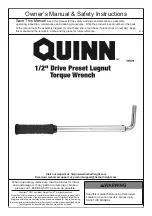
1 TRIMMASTER 16A ANGLED BRADDER MANUAL
TRIMMASTER 16A ANGLED BRADDER MANUAL 2
Congratulations on the purchase of your new Paslode Cordless TrimMaster 16A Angled Bradder.
GENERAL SAFETY INSTRUCTIONS
TABLE OF CONTENTS
The Impulse system consists of: tool, fuel cell, battery,
charger and fasteners. In the interests of operator
and system safety, the tool, fasteners and the fuel
cells referred to in the Paslode documents, must be
considered as one single, complete safety system.
WARNINGS
DO NOT ATTEMPT TO OPERATE
THIS TOOL UNTIL YOU HAVE
READ AND UNDERSTAND ALL
SAFETY PRECAUTIONS AND
MANUAL INSTRUCTIONS.
The Paslode Cordless TrimMaster 16A
Angled Bradder is an internal combustion
device. It produces hot exhaust gases
that may ignite flammable materials. This
tool must not be used in a combustible
environ ment or in the presence of
combustible materials, such as flammable
chemi cals, adhesives, gasoline, or
solvents.
Failure to follow all safety precautions and
instructions may result in a permanent
loss of vision, serious personal or even
fatal injury, property damage and/or tool
damage.
Do not expose the tool to temperatures in
excess of 49°C (120°F). Fuel and/or the
battery may burst, releasing flammable
gas.
This tool must be operated only in a well-
ventilated environment, because the tool
exhausts carbon monoxide similar to a
petrol/gasoline lawnmower. Exposure to
carbon monoxide may cause dizziness,
nausea, or unconsciousness.
ALWAYS keep the Paslode Cordless
TrimMaster 16A Angled Bradder fuel cell,
battery and battery charger out of the
reach of children.
ALWAYS wear eye and ear safety
equipment (PPE) when working with
or in the vicinity of the Paslode Impulse
16A TrimMaster.
The Impulse 16A TrimMaster should not
be used in the rain or where excessive
moisture is present.
MAINTENANCE
Restrict Field Maintenance to the following:
CHECKING THE ENERGY LEVEL OF THE BATTERY
RECHARGING THE BATTERY
CHECKING THE FUEL CELL
REPLACING THE FUEL
CLEANING/REPLACING THE AIR FILTER
CLEARING A JAM
CLEANING AND LUBRICATING THE TOOL
(SEE UPDATED INSTRUCTIONS VIA QR CODE (PG 11)
CAUTION
Never attempt any maintenance of a
Paslode Impulse tool without first
removing the fasteners, fuel cell and
battery. Maintenance should be started
only after the tool is inoperative.
Operators should be capable of conducting basic
maintenance on the tool.
This will not affect your tool
warranty.
FUEL CELL CHECK
Check the fuel cell. First remove the fuel cell from the tool
and check the “Best Use Before” date stamped on the
bottom of the cell.
CLEARING A NAIL JAM SAFELY
1. Remove the battery, fuel and fasteners.
2. Lift the Nose Plate latch to expose the Brad.
3. Clear jam, and push driver blade back up to its
rest position at the top of the cylinder.
4. Close Nose Plate and reset the latch.
FUEL CELL DISPOSAL
Dispose of all empty fuel cells responsibly. Remember to
dispose of these fuel cells where they will not be crushed,
punctured, burned or found by children.
Refer to your local authority regulations.
GENERAL SAFETY INSTRUCTIONS ..................................................................2
TOOL SAFETY INSTRUCTIONS .........................................................................3
BATTERY SAFETY & CHARGING ......................................................................4
FUEL CELL SAFETY ...........................................................................................5
TOOL OVERVIEW...............................................................................................6
FUEL CELL LOADING PROCEDURE ................................................................7
CORRECT TOOL OPERATING PROCEDURES ..................................................8
PREPARING AND USE OF TOOL ......................................................................9
TROUBLESHOOTING ........................................................................................10
TOOL MAINTENANCE ......................................................................................11
TOOL SPECIFICATIONS ....................................................................................12
SCHEMATICS ....................................................................................................13



























